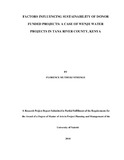| dc.description.abstract | This study investigated factors influencing sustainability of donor funded water projects
in Tana River County, Kenya. The guiding objectives include; establishing the influence
of Monitoring and Evaluation (M&E) on sustainability of donor-funded projects, to
assess the influence of level of funding and establish how the involvement of
stakeholders influences sustainability of donor funded water projects in Tana River
County. The study applied quantitative research design, which makes use of
questionnaires to gather information. Quantitative research incorporates the statistical
elements designed to quantify the extent to which the target group is aware of, thinks and
believes. The study targeted fifty (50) respondents; comprising of Ten (10) technical
persons from line ministries, Ten (10) donor agency representatives and thirty (30)Water
Point Executive Committee (WPEC) members; comprising of (Chairman, Secretary and
Treasurer). The representatives were aware about the management, technical decisions
within their departments of work, and are involved in daily operation and had the
required information for the success of this study in Wenje Donor Funded Water Projects
in Tana River County. Census sampling method involving inclusion of all target
population into the sample followed by purposive sampling methods was applied.
Purposive sampling method which relies on the researcher‟s judgment; in selecting
respondents regarding those special participants who had specific information of interest
to the study was applied. The information of number of Water Point Executive
Committees was sourced from WESCOORD Coordination body in Tana River and
Conslog Engineering Services, a consultancy firm/NGO operating in Wenje Division.
Data collected was analysed using descriptive statistics where relative frequency
distribution tables as well as mean and standard deviations values were calculated with
the help of Likert scale ratings of (1,2,3,4 and 5) in the analysis. Standard deviations were
calculated to denote the variability of responses around mean values in the likert rating
scale so as to ascertain consistency of responses among respondents. The findings of the
study were presented in frequency distribution tables. It could be concluded that; all
donor funded water projects were not sustainably managed. The researcher recommended
for a more strategic oriented water projects management, which would be the pro-active
approach, to be adopted in the community water projects management. This would help
by negating the current water management practices that are still focused on reacting to
events that have already occurred: the re-active approach. The researcher suggested that
further studies on factors influencing sustainability of donor funded water projects both in
Kenya and the rest of the world should be conducted. A study on various water use and
demand sites such as the: domestic, agriculture, livestock and other uses would help the
policy makers/donor agencies or the water projects developers on the approximate water
demands per community. Also a study on the community preparedness to participate and
manage the donor funded water projects long after the completion of the projects,
regardless of other sources of cheap water among other obstacles was suggested. | en_US |

